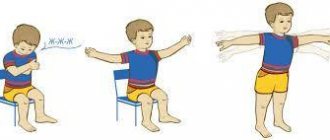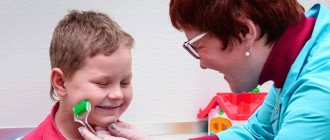Card index of non-traditional exercises for improving articulatory motor skills
Non-traditional exercises to improve articulatory motor skills
Exercises with a ball
The diameter of the ball is 2-3 cm, the length of the rope is 60 cm, the rope is threaded through a through hole in the ball and tied in a knot.
1. Move the ball along the rope stretched horizontally on the fingers of both hands with your tongue to the right and left.
2. Move the ball up along a vertically stretched rope (the ball falls down randomly).
3. Push the ball up and down with your tongue, the rope is stretched horizontally.
4. Tongue - “cup”, goal: to catch the ball in the “cup”.
5. Catch the ball with your lips, push it out with force, “spitting” it out.
6. Catch the ball with your lips. Close your lips as much as possible and roll the ball from cheek to cheek.
7. Tell tongue twisters with a ball in your mouth, holding a string with your hands.
Note. While working, the adult holds the rope in his hand. After each lesson, rinse the ball and string thoroughly with warm water and baby soap and dry with a napkin. The ball must be strictly individual.
Non-traditional exercises to improve articulatory motor skills
Exercises with a spoon
1. Hold a teaspoon in your fist and place it to the corner of your mouth, push your tongue into the concave side of the spoon to the left and right, turning the hand with the spoon accordingly.
2. Push the spoon up and down into the concave part.
3. The same, but push the spoon into the convex part.
4. Tongue - “spatula”. Tap the convex part of a teaspoon on your tongue.
5. Apply pressure with the edge of the spoon onto the relaxed tongue.
6. Press the spoon tightly against the lips in front of the lips, folded into a tube, with the convex side and make circular movements clockwise and counterclockwise.
7. Stretch your lips into a smile. Use the convex part of a teaspoon to make circular movements around your lips clockwise and counterclockwise.
8. Take a teaspoon in your right and left hand and make light patting movements on your cheeks from bottom to top and top to bottom.
9. Circular movements with teaspoons on the cheeks (from nose to ears and back).
10. Patting teaspoons on the cheeks with both hands simultaneously from the corners of the mouth stretched in a smile to the temples and back.
Non-traditional exercises to improve articulatory motor skills
Tongue exercises with water
"Don't spill the water"
1. The tongue in the shape of a deep “bucket” with a small amount of water (water can be replaced with juice, tea, compote) is strongly protruded forward from the wide open mouth. Hold for 10 - 15 seconds. Repeat 10 - 15 times.
2. The “tongue-bucket” with liquid smoothly moves alternately to the corners of the mouth, holding the liquid without closing the mouth or pulling back into the mouth. Performed 10 times.
3. The “bucket tongue” filled with liquid moves smoothly back and forth. The mouth is wide open. Performed 10 - 15 times.
Non-traditional exercises to improve articulatory motor skills
Exercises for lips and tongue and jaws with a bandage
Disposable bandage, strictly individual, dimensions: length 25-30 cm, width 4-5 cm.
1. The lips, closed and stretched into a smile, tightly compress the bandage. An adult tries to pull out the bandage, overcoming the resistance of the lip muscles. Performs within 10 - 15 seconds.
2. Performed by analogy with exercise 1, but the bandage is clamped with the lips in the left and then in the right corners of the mouth alternately. Performed 10 times.
3. The bandage, held between the lips in the right corner of the mouth, is moved without the help of hands to the left corner, then, conversely, from the left to the right, etc. Performed 10 times.
4. Unlike exercise 1, the bandage is bitten, clamped tightly not with the lips, but with the front teeth and held for 10-15 seconds, the clamp is loosened for a few seconds. Clamping - relaxation alternate 10 - 15 times.
5. The bandage is bitten and clamped not by the incisors, but by the molars, alternately with the left and then with the right. Performed 10 times.
6. The bandage tightly presses the tongue, raised upward in the shape of a wide bucket or “scapula” (pancake), to the entire surface of the upper lip. At the same time, the mouth is wide open. The adult, as in exercise 1, tries to pull out the bandage, overcoming resistance. Hold this position for 10-15 seconds. Repeated up to 10 times.
7. Unlike exercise 6, the bandage is pressed with a “bucket tongue” (“spatula”, “pancake”) not to the entire surface of the upper lip, but to the left and then to the right corner of the mouth alternately. Performed in the same way as exercises 1, 6.
8. The bandage is pressed firmly against the entire surface of the lower lip with a wide, soft tongue in the shape of a “scapula” (“pancake”).
Article "Bioenergoplasty - an unconventional form of articulatory gymnastics"
Bioenergoplasty is an unconventional form of articulatory gymnastics
A.G. Manushina, teacher-speech therapist, MBDOU "Kindergarten "Solnyshko", Onega
Modern socio-economic conditions place new demands on the preschool education system. At the present stage, a transition has been made to a new level of education. With the advent of the new federal state educational standard, the search for new forms and methods of teaching and raising children has become one of the pressing issues of pedagogy. Increased attention to the development of a child’s personality is associated with the possibility of updating and qualitatively improving his speech development. Therefore, along with generally accepted techniques, it is quite justified to use original, creative techniques, the effectiveness of which is obvious. And in this case, bioenergoplasty, as one of the methods of health-saving technologies, is an effective means of correcting sound pronunciation in preschool children.
Speech sounds are formed as a result of complex movements of the tongue, lips, jaws, and for each of them there is a certain articulation pattern. Even minor deviations from the norm in the location of the organs of articulation lead to defective pronunciation of speech sounds. Therefore, it is very important to form the necessary articulatory patterns and develop various muscles of the speech apparatus. For this purpose, speech therapists successfully use articulation gymnastics in their work, which includes a set of specific exercises aimed at improving the basic movements of the articulation organs. Daily gymnastics classes, unfortunately, reduce children's interest in this process, which, in turn, leads to a decrease in the effectiveness of performing articulation exercises. Therefore, we turned to an unusual and non-standard method of performing articulatory gymnastics - the use of bioenergoplasty. Such gymnastics helps to maintain the child’s interest for a long time, helps to increase the motivational readiness of children for classes, and maintains a positive emotional mood of the student and teacher.
The goal of articulatory gymnastics is to develop correct, full-fledged movements of the articulatory organs necessary for correct sound pronunciation, and to combine simple movements into complex articulatory patterns of sounds together with movements of the hands. For the correctional work of speech therapists, the most significant is the combination of bioenergoplasty (smooth movements of the hands) with movements of the organs of the articulatory apparatus. When performing an articulation exercise, the hand shows where and in what position the tongue, lower jaw or lips are located.
To achieve better results when preparing the articulatory apparatus for producing sounds, so that the process is more entertaining and captivates children, we use a method such as bioenergoplasty. To all classic articulation exercises we add the movement of the hand. To increase motivational readiness and maintain the child’s interest for a long time when performing gymnastics, we use a non-standard method of performing exercises - articulatory gymnastics with bioenergoplasty.
The term “bioenergoplastics” consists of two words: bioenergy and plastic. According to I.V. Kuris, bioenergy is the energy that is inside a person. Plasticity is smooth, liberated movements of the body and hands, which are the basis of bioenergoplasty. “Bioenergoplastics” includes three basic concepts: bio - a person as a biological object: energy - the force necessary to perform certain actions; plasticity is a movement associated with plasticity, which is characterized by continuity, energetic fullness, and emotional expressiveness.
For the correctional work of speech therapists, the most significant is the combination of bioenergoplasty (movements of the hands) with movements of the organs of the articulatory apparatus. When performing an articulation exercise, the hand shows where and in what position the tongue, lower jaw or lips are located. Such gymnastics helps to retain the child’s interest for a long time, helps to increase children’s interest in performing articulatory gymnastics, and maintains a positive emotional mood in children and the teacher throughout the entire lesson. The use of bioenergoplasty effectively speeds up the correction of defective sounds in children, since the working palm repeatedly amplifies the impulses going to the cerebral cortex from the tongue. It has a beneficial effect on enhancing the intellectual activity of children and develops fine motor coordination. The use of bioenergoplasty effectively speeds up the correction of defective sounds in children with reduced and impaired kinesthetic sensations, since the working palm greatly enhances the impulses going to the cerebral cortex from the tongue. Bioenergoplasty optimizes the psychological basis of speech, improves the child’s motor abilities in all respects, and promotes the correction of sound pronunciation and phonemic processes. Synchronizing work on speech and fine motor skills halves the time of classes, not only without reducing, but even increasing their effectiveness. It allows you to quickly remove the visual support - the mirror - and move on to performing exercises based on sensations. This is especially important since in real life children do not see their articulation.
Advantages of using a set of articulation exercises with elements of bioenergy plastic:
Optimizes the psychological basis of speech.
Improves the child's motor abilities in all respects.
Promotes correction of sound pronunciation and phonemic processes.
Synchronizing work on speech and fine motor skills reduces the time of classes and enhances their effectiveness.
Allows you to quickly remove the visual support – the mirror and move on to performing exercises based on sensations.
Thus, the use of articulatory gymnastics with bioenergoplasty helped to attract children’s interest in performing exercises, which significantly increased the effectiveness of gymnastics, contributed to the development of articulatory and finger motor skills, improved coordination of movements, and the development of memory, attention, and thinking. Performing elements of gymnastics with the hands and tongue requires the child to have maximum concentration of visual and auditory attention, developed spatial orientation, precise movements of the fingers and hands together with movements of the tongue or lips. Strong motivation and the use of the game method in classes developed and strengthened the muscles of the articulatory apparatus, which greatly facilitated the formulation and introduction of sounds into speech.
The use of bionergoplasty helps to achieve positive results in a short time. Dynamic exercises normalize muscle tone, switchability of movements, making them precise, easy, and rhythmic. The use of bioenergoplastics creates the prerequisites for the development of coordination, voluntary behavior, memory attention and other mental processes.
Literature
Zaitseva I. Yu. The influence of bioenergy plastics classes on the speech development of preschool children. — Access mode: https://festival.
Dudiev V.P. Means for the development of fine motor skills in children with speech impairment. //Defectology. 1999. N4. Krause, E. N.
Lazarenko O.I. Training the articulatory apparatus and fingers // Education and training of children with developmental disorders. M., 2006. No. 2. P. 28.
Speech at the RMO on the topic “Unconventional method of articulatory gymnastics.”
Articulatory gymnastics is similar to morning exercises: it increases blood circulation, develops the flexibility of the speech apparatus, and strengthens the facial muscles. In order for a child to pronounce sounds correctly, his lips and tongue must be strong and his movements precise. There is an opinion that articulatory gymnastics is not so important, frivolous, sometimes even boring, an activity that you don’t have to do. How to perform articulatory gymnastics at home so that your child finds it interesting? I answer you - cheerfully and with pleasure. To do this, in addition to generally accepted articulation exercises, you are offered non-traditional exercises that are playful in nature and evoke positive emotions in children."Hold tight"
Hold a cotton swab (straw, pasta, spoon, dryer) on the tongue, tongue on the lip, on the cheek, between the lip and nose. And vice versa, try to “take away” objects held by the tongue and lips from the child, overcoming the resistance of the muscles of the lips and tongue.
"Beads"
Place large cookie crumbs or small round candies on a plate. We ask the child to collect them with his lips, imagining that he is collecting scattered beads. Or we ask you to move the “beads” from one plate to another with your lips.
"Sweet Football"
Roll a large grape, a walnut, a cracker, a piece of sugar, a large round caramel, etc. in your mouth from one cheek to the other.
"Delicious jam"
Lick jam, honey, condensed milk (or other product that is not contraindicated for a child) from the lips, from a saucer, from cookies, from crackers, etc.
"Oh, how delicious"
Sprinkle a sticky plate with small crumbs of bread, crackers, cookies, sugar, candy and ask the child to lick the surface of the plate
"Fishing"
Sprinkle the sticky plate with larger crumbs. We invite the child to catch a fish, the tongue is a fishing rod, and the crumbs are fish. You need to open your mouth wide, stick out your tongue with a needle and touch the crumb so that it sticks to the tip of your tongue. It needs to be done quickly and accurately.
"Beautiful Cookies"
Using the tense tip of your tongue, count the ribs on the shaped cookies.
“Who’s next?”, “Get into the saucer”
Spitting raisins, peas, corn, etc. from the tip of the tongue.
"Ugh"
There are crumbs on the plate. The child takes a crumb from the plate with his lips, holds it between his lips and spits it back - ugh.
“Hamster”
(during bathing)
The child takes clean water into his mouth so that both cheeks are puffed up. Then he hits his cheeks with his fists and forcefully releases a stream of water. You can take a little water and push it from one cheek to the other.
"Tooth Fairy"
We brush our teeth with a toothbrush, massage our tongue and cheeks.”
"Chewing gum"
If it is not contraindicated, we give the child soft chewing gum in the form of a large lump and ask him to chew. It is difficult to chew a large lump of chewing gum, so the child will develop his jaws, work with his tongue, swallow drool, etc., that is, activate the mobile organs of articulation.
«Chewy candy"
The child chews the chewing candy, sticks it to the hard palate with his tongue, and then tries to tear it off with the tip of his tongue. Thus, the baby practices voluntary lifting of the tongue upward.
"Bullseye"
We put a piece of apple on the child’s cheek and ask him to pull it out with his tongue. This is also done with the other cheek.
"Cup"
We ask the child to stick out his wide tongue and make a “cup”. Place a vitamin or candy into a cup and hold for 5-8 seconds. You can drip water from a pipette into the “cup” and then swallow it.
Exercises with a large bead
The diameter of the bead is 2-3 cm, the length of the rope is 60 cm, the rope is threaded through a through hole in the bead and tied in a knot.
1. Move the bead along the rope stretched horizontally on the fingers of both hands with your tongue to the right and left.
2. Move the bead up along a vertically stretched rope (the bead falls down randomly).
3. Push the bead up and down with your tongue, the rope is stretched horizontally.
4. Tongue - “cup”, goal: to catch the bead in the “cup”.
5. Catch the bead with your lips and forcefully push it out, “spitting” it out.
6. Catch the bead with your lips. Close your lips as far as possible and roll the bead from cheek to cheek.
7. Tell tongue twisters with a bead in your mouth, holding a string with your hands.
Note.
While working, the adult holds the rope in his hand. Wash the bead and string thoroughly after each lesson. The bead must be strictly individual.
Tongue exercises with water “Don’t spill the water”
1. The tongue in the shape of a deep “bucket” with a small amount of water (water can be replaced with juice, tea, compote) is strongly protruded forward from the wide open mouth. Hold for 10 - 15 seconds. Repeat 5-10 times.
2. The “tongue-bucket” with liquid smoothly moves alternately to the corners of the mouth, holding the liquid without closing the mouth or pulling back into the mouth. Performed 5-10 times.
3. The “bucket tongue” filled with liquid moves smoothly back and forth. The mouth is wide open. Performed 5-10 times.
Exercises for lips and tongue and jaws with a bandage
Disposable bandage, strictly individual, dimensions: length 25-30 cm, width 4-5 cm.
1. The lips, closed and stretched into a smile, tightly compress the bandage. An adult tries to pull out the bandage, overcoming the resistance of the lip muscles. Performs within 10 - 15 seconds.
2. Performed by analogy with exercise 1, but the bandage is clamped with the lips in the left and then in the right corners of the mouth alternately. Performed 10 times.
3. The bandage, held between the lips in the right corner of the mouth, is moved without the help of hands to the left corner, then, conversely, from the left to the right, etc. Performed 10 times.
4. The bandage tightly presses the tongue, raised upward in the shape of a wide bucket or “spatula” (pancake), to the entire surface of the upper lip. At the same time, the mouth is wide open. The adult, as in exercise 1, tries to pull out the bandage, overcoming resistance. Hold this position for 10-15 seconds. Repeated up to 10 times.
5. Unlike exercise 4, the bandage is pressed with a “bucket tongue” (“spatula”, “pancake”) not to the entire surface of the upper lip, but to the left and then to the right corner of the mouth alternately. Performed in the same way as exercises 1, 4.
“Sweet exercise” (exercises with lollipop)
You might be surprised, but the round sweet lollipop is chups.
- an excellent speech therapy simulator. Unwrap the candy canes and let's play a little.
- squeeze the lollipop with your lips and try to hold it for 5-10 seconds.
— holding the lollipop with your lips, try moving the stick first from top to bottom, then from side to side.
- open your mouth slightly, lips parted into a smile, make a cup, put lollipop in the cup and try to hold the lollipop with your tongue only.
- raise your wide tongue to the sky, press the lollipop “fungus” to the palate.
- move the lollipop along the midline of the tongue from tip to root and back 5-10 times.






